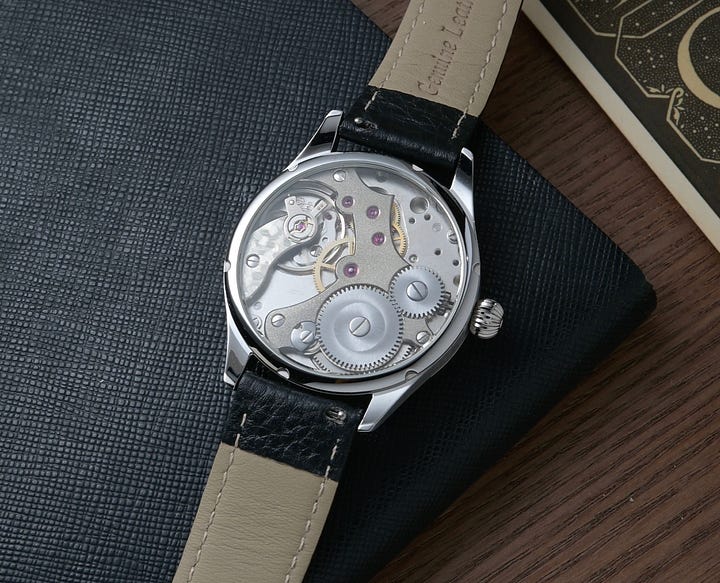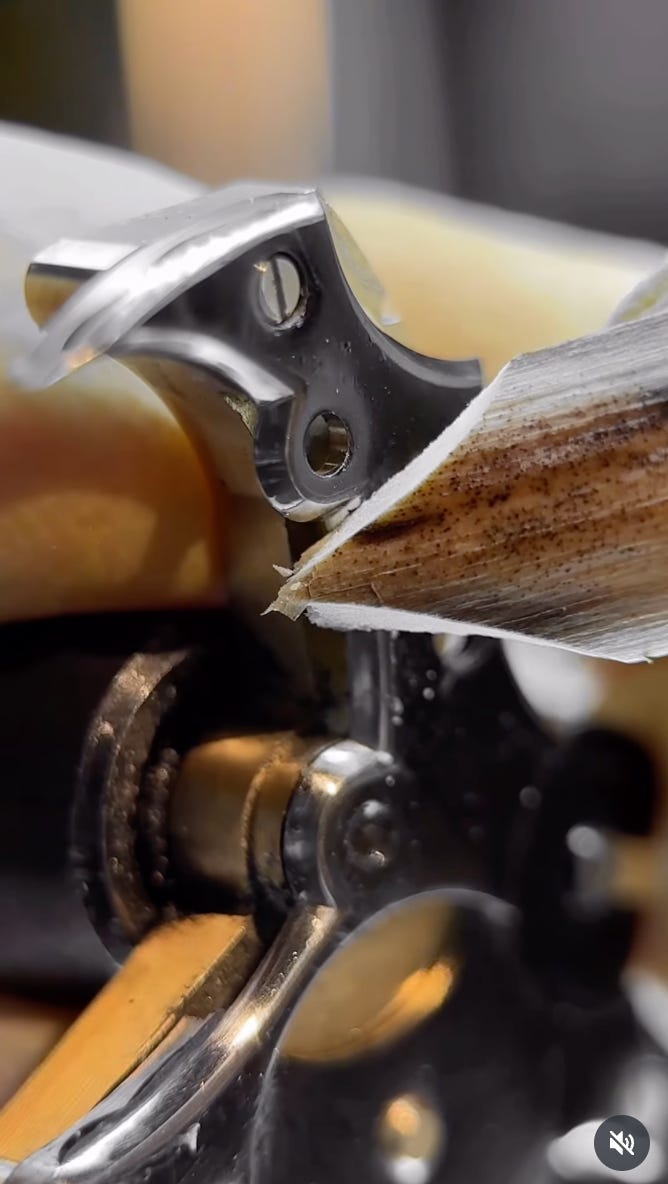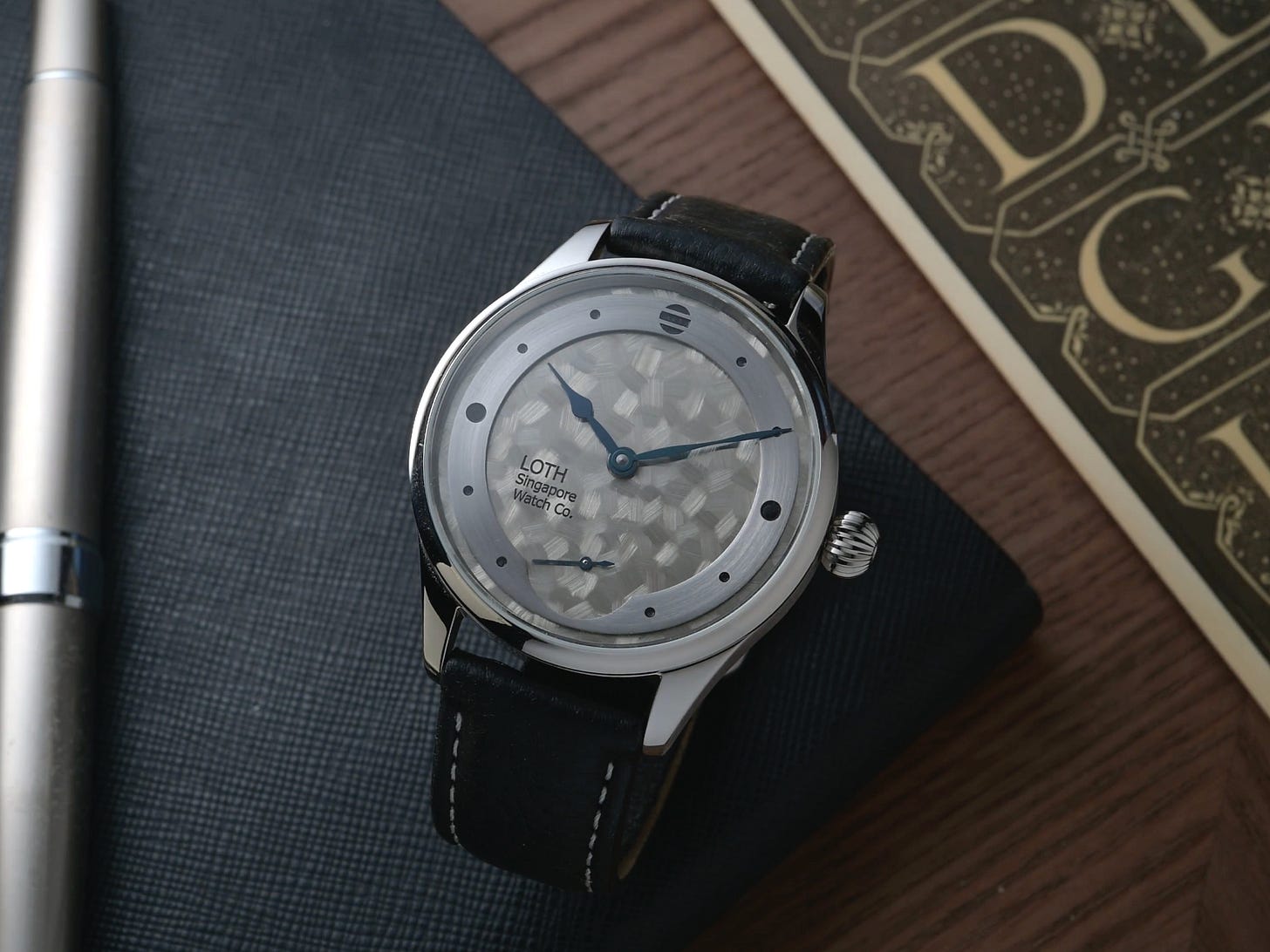How Hand-Finishing Became the New Complication
Once a hidden detail, hand-finishing is now a visible signal of value, status, and hype. But what happens when everyone chases the same angles?
Lately, I’ve been fascinated by our obsession with finishing. Collectors talk about sharp inner angles the way we used to talk about chronographs or perpetual calendars. Watchmakers—especially independents—are building entire brands around bevels and black polish.
Finishing is a vital part of watchmaking, no doubt. But it’s not everything. And sometimes, the shine of a mirror polish can distract from the substance underneath.
To dig into this shift, I asked Nabil Amdan to explore the rise of hand-finishing. Nabil has written in-depth collector guides for Hairspring, and brings that same clarity and curiosity here, speaking with Laurent Ferrier, journalist Jack Forster, and the young Singaporean watchmaker behind LOTH Watches to trace the rise (and potential cost) of our finishing fixation. Let’s get into it.–Tony
How Hand-Finishing Became the New Complication
By: Nabil Amdan

“Hand-finishing is the silent language of haute horlogy,” Laurent Ferrier tells me. “It requires not only technical precision, but an artistic sensibility developed over years of experience.” That statement no longer applies only to indies like Ferrier—it’s reshaping watch collecting across the board.
Hand-finishing is no longer a hidden flourish. Anglage, black polish, perlage, and Côtes de Genève—once background details—are now celebrated in Instagram reels, deep dives, and collector chats.
To explore this current obsession from all angles, I spoke with one of the masters of the craft, a veteran journalist, and a self-taught rising from Singapore.
From Movement to Movement Finish


“Watch finishing was a matter for watchmakers, not clients,” says journalist and editor Jack Forster. “That started to shift in the late ’90s and early 2000s, when fine finishing, along with in‑house movements, became critical points of differentiation between industrial and fine watchmaking.”
A pivotal catalyst came with the rise of the sapphire display caseback. “Before the Quartz Crisis, owners rarely saw the movement,” says Forster, “suddenly, finishing became part of the conversation—and part of a watch’s identity.”
Forster traces the early finishing conversations to 2000s forums, but says Instagram made it mainstream. “The obsession wouldn’t have happened without Instagram,” he says. “It expanded the conversation from niche forums to a global audience. Suddenly, inner angles and polished screws became the new gold standard.”
He gives much of the credit to one man: Philippe Dufour. “Dufour has been very vocal for years about what he perceives as a diminishment of finishing standards in Switzerland,” says Forster. The meticulous finishing of Dufour’s Simplicity, released in 2000, set the benchmark and inspired a generation of independent watchmakers—and collectors.
Why Hand-Finishing?

For Laurent Ferrier, finishing is essential for both aesthetic and functional reasons.
“For example, perlage must feel organic—not mechanical or overly uniform. Each technique serves a purpose: to reduce friction, enhance beauty, or simply honor the traditions of fine watchmaking.”
Techniques such as anglage, black polishing, and Côtes de Genève are foundational. Mastering them takes several years of dedicated practice.
“Our decorators often train for two to three years before they are entrusted with the most critical components,” he says. Every bevel and screw head signals quality, patience, and skill.
This shift has been liberating for Tristan Ho, a young independent watchmaker and founder of LOTH Watches in Singapore. “I started making watches because I was inspired by the sharp angles and meticulous finishes of Minhoon Yoo, Felipe Pikullik, and Lang & Heyne,” Ho says. “I noticed many brands charging exorbitant prices for rounded corners or skipping inner angles altogether. So I set out to make a movement with world-class angles from my own workshop.”


Ho approaches finishing as both a technical and an artistic endeavor. He uses traditional tools such as files, sandpaper, and a loupe, but also modern tech like a high-res microscope to ensure precision.
“Every scrape uses fresh sandpaper, and every direction is intentional,” he says.
From Feature to Fetish?
Finishing has become the flex of the moment in part because it’s instantly visible. You don't need to understand torque or escapements to appreciate a mirror polish. Its beauty doesn’t require an engineering degree.
But, as finishing moves from the atelier to Instagram, it also risks becoming fetishized. “The best finishing has become an end in itself in a way it historically wasn’t,” Forster says. “Traditionally, fine finishing was an expression of craft, a natural extension of making a watch well. You didn’t finish a component for its own sake, especially if it was buried deep in a movement. Today, finishing is treated like a standalone commodity.”
That’s especially relevant in an era where machine finishing can mimic handwork. “A lot of so-called hand-finishing at ‘accessible’ price points should be taken with a healthy dose of skepticism,” says Forster.
True hand-finishing is at the end of a continuum—from mass production to the meticulous work of Dufour or Rexhepi. Not every watch needs it, though many now claim it.
Finissage Façade
But what happens when machines can imitate human craft? With high margins and low visibility, it’s easy for brands to exaggerate (or outright lie) about the amount of handwork in a watch.
There’s no certification body for anglage. Anyone can claim it’s hand-done. Some brands apply simple machine-chamfering and then finish the edges manually to pass off as hand-finished. To the naked eye, or even under a loupe, it’s hard to spot.
Often, the line between true hand-finishing and machine-assisted work is deliberately blurred.
Brands like Blancpain can use rotary hand tools, like electric polishing pens or abrasive-tipped micromotors that are guided by hand, producing uniform results that mimic artisanal anglage. This hybrid approach is frequently marketed as 'hand-finishing' because there’s technically a human guiding the tool.


But real hand-finishing is done entirely with manual tools like files and wood pegs, producing subtle, organic variations that machines can’t replicate. Watch brands are storytelling machines, but if the craftsmanship narrative doesn’t hold up, collectors get wise.
Handcraft is core to luxury. If finishing becomes a fetish divorced from horology, the next generation might stop caring. Not because they lack taste, but because they know the polish can be faked. As finishing drives pricing, the temptation to fake it grows.
Unpolished Classifieds
The Unpolished Classifieds are a place to promote cool things to our 10k+ subscribers. Promote your event, sale, newsletter, app, book, tools, or accessories. No watch brand ads. Price: $500 for four ads. Max. 300 characters. Reply to this email if you’re interested.
🎉 Minutes + Hours Los Angeles
Explore over 60 brands and thousands of watches at the Minutes + Hours Show in Los Angeles, July 26–27. See, try and buy microbrands, indies & more. Get your free tickets now:
The Trickle-Down Effect
In recent years, finishing has trickled down from the upper echelon of independents to microbrands like Furlan Marri and Atelier Wen, which now offer visible hand-finished angles and polished screws for under $2,000. “It’s definitely being done because there’s a perception that it’s what the market wants,” says Forster. “But I’d be wary of expecting too much at an accessible price point.”

Ferrier sees both benefits and caveats. “It helps educate,” he says, “but I’m concerned the true value of artisanal finishing could be diluted by comparisons to machine work or hollow marketing.”
Meanwhile, Ho embraces the trend, seeing it as bringing transparency to the conversation.
What’s Next
As hand-finishing becomes a point of emphasis, its role is being redefined. Will it remain a niche concern, a hallmark of exclusivity for those in the know, or will it evolve into a commodity that can be mimicked by machine?
“I’m concerned the true value of artisanal finishing could be diluted by comparisons to machine work or hollow marketing.”–Laurent Ferrier
Forster doesn’t expect hand finishing to disappear, but he also doesn’t see it becoming truly mainstream. “It’s never been anything other than niche,” he says. “The major luxury brands (Omega, Rolex) used hand finishing across their wider production when annual output was in the low thousands. You can’t expect Dufour- or Rexhepi-level finishing from a brand making tens of thousands of watches a year.”
Ferrier agrees and says that true hand-finishing will remain in the hands of independent ateliers and a few old houses upholding the rhythm and philosophy it demands.
Ho views this moment as a kind of proving ground. “My strict and uncompromising adherence to technical precision is my artistic expression,” he says. In a landscape where consumers are becoming more educated and more skeptical, makers like him are trying to show that substance can match the story.
The Final Angle
So where does hand-finishing go from here?
Likely two ways.
At the high end, the ceiling is still rising. Watchmakers like Petermann Bédat, Sylvain Pinaud, and the Rexhepis are raising the bar, each producing fewer than 100 pieces per year.
At the entry level, there is more segmentation: machine-finished work that mimics handwork, next to truly artisanal pieces with transparent documentation.
But I can’t help wondering if our collective obsession with hand-finishing has started to flatten the creative landscape. What began as an appreciation for rare craft can start to feel like an aesthetic monoculture. Collectors chase Rexhepi, then Brette, then whoever comes along next with the sharpest inner angles.
This can lead to a growing sameness among independent watchmakers looking to meet this demand. Don’t get me wrong, I love a good inner angle. But I also wonder if we’ve lost other forms of watchmaking or artistic expression to our collective obsession with finishing.
As finishing continues to drive value, it also demands scrutiny—from brands, journalists, and collectors.
Because the real question isn’t just: “Is this hand-finished?”
It’s: “By whose hand, and to what end?”





The reductio ad absurdum on this argument is right here: "But real hand-finishing is done entirely with manual tools like files and wood pegs, producing subtle, organic variations that machines can’t replicate."
I own an A. Schumann "precise drilling machine," effectively a jeweler's drill press from 1890. A. Schumann relocated from Dusseldorf to Racine, WI in 1939 for all the reasons you'd expect and became Precise Manufacturing, the pre-eminent rotary tool globally. Rockwell bought Precise in 1969 and then sold it to Fischer SFJ in 2006, the manufacturer of precision spindles used by Kern, Bumotec and others. It was state-of-the-art in 1890, and modern state-of-the-art tools can trace their lineage directly to it. The barriers to entry are unchanged and prices were comparable.
I own it because the former owner couldn't get it to spin reliably under power - something something 130-year-old babbitt bearings something something. He wanted to do perlage with it, and couldn't. Perlage ("engine turning" for those outside the niche tradition of watch finishing) simply can't be done in a reasonable fashion without reasonable RPM and life is too short. This is a guy who sinks hundreds of hours into his watches and he noped the hell out.
How is it that "real hand finishing" is done entirely with manual tools, yet perlage *can't* reasonably be done entirely with manual tools?
At a baseline, luxury item pricing = (("cost per hour per craftsman" x "hours worked") + ("material inputs") x ("markup")) x ("duty coefficient"). The material inputs on a gold Rolex and a gold Dufour aren't wildly different, nor are the "cost per hour per craftsman" - Dufour is doing it all himself and Rolex is dozens of craftsmen but technicians at the same level of proficiency can do the same work in the same amount of time. The real difference is some indie is gonna spend 40 hours per dial doing hand guilloche on a 140-year-old Lienhard while Patek is gonna feed it into their $750k S191V and call it a day.
The differences are this:
1) The indie guy doesn't have to drop three quarters of a mil on a 9-axis mill-turn
2) The LVMH house can clobber the indie on price through economies of scale
The hand-finishing fetish is an outcome of Kickstarter, not Instagram. Swiss (not American) watches have long been a parts bin of different cottage industries assembled under a single name of origin and the advent of AliExpress allowed a Cambrian explosion of internet simps cobbling together Another Damn Diver out of a dozen Shenzen parts houses to pimp on social media. The only way to differentiate one Lego watch from another Lego watch was to put some hand-lovin' on it and it doesn't take much in the way of tooling to "hand finish" a movement. The end result was the ever-credible watch press parroting marketing copy, the ever-credible watch enthusiast community parroting the watch press, and chin-stroking arguments about how much "hand" is necessary in "hand finishing" when ultimately, "visible hand-finished angles and polished screws for under $2000" is about market differentiation rather than quality.
Is a custom cannon pinion somehow worth more if the watchmaker's lathe is turned with a foot treadle rather than a sewing machine motor? C'mon now.
I leave you with this: Audemars fetishizing their mechanization to the point of pr0n.
https://youtu.be/K0uW37FnCLM?si=AIM8X8lzpq48IQzj
SJX was insightful talking about this on his latest podcast; a point he has made before is that there is a raft of time-only independents where the whole point is the hand-finishing (ie there is nothing technically interesting about the movement) and that’s just not that interesting anymore.
It is clearly what the market wants, but it is a different time now than when Dufour did it with the Simplicity (which falls 100% in to the category of good but pretty standard time-only movement beautifully decorated).
I have a lot of sympathy with his view. I’m much more interested in horological innovation than I am in Swiss-style hand-finishing.